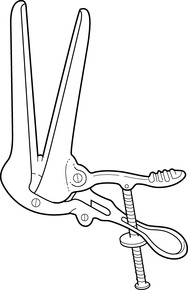28. Facilitation of related childbearing skills
speculum use
CHAPTER CONTENTS
Indications193
Cusco speculum193
Role and responsibilities of the midwife194
Summary195
Self-assessment exercises195
References195
LEARNING OUTCOMES
Having read this chapter the reader should be able to:
• discuss the indications for using a Cusco speculum
• describe how to insert the speculum
• discuss the role and responsibilities of the midwife in relation to speculum use.
A speculum is an instrument that is inserted into the vagina to open the vaginal walls and allow access to the top of the vagina and cervix. It can be an uncomfortable and embarrassing procedure for the woman and it is important it is undertaken correctly and sensitively. This chapter focuses on the use of the Cusco speculum.
Indications
The midwife may need to use a speculum:
• during preterm labour to assess the cervix
• to inspect around the top of the vagina and cervix for the presence of amniotic fluid when prelabour rupture of membranes is suspected
• to obtain a high vaginal swab
• to obtain a cervical smear.
Cusco speculum
The speculum is made of either metal (reusable) or plastic (disposable). It has two short blades that are curved across their width (Fig. 28.1). When the speculum is closed the blades close together, but when it is opened they separate to press against the vaginal walls. At one end there is a circular opening through which the vagina and cervix can be visualised and swabs inserted when required. Attached to this end are the handles that open and close the speculum by means of a screw mechanism. When the handles are apart the blades are closer together. To open the blades, bring the handles together. When inserting the speculum, ensure it has been introduced far enough into the vagina otherwise it will be difficult to visualise the cervix and take a swab (Hardy 2007).
 |
| Figure 28.1 • Cusco speculum (Adapted with kind permission from Chilman & Thomas 1987) |
Stay updated, free articles. Join our Telegram channel

Full access? Get Clinical Tree


